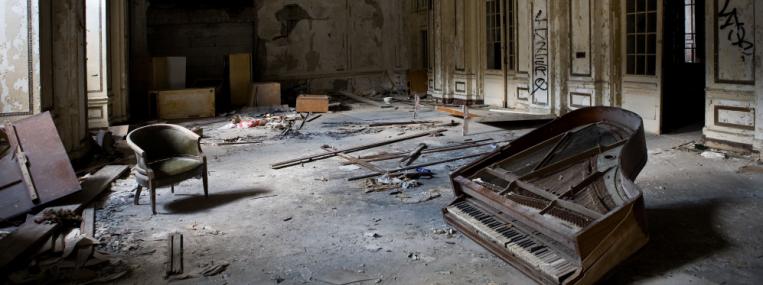
Rejecting Ruin Porn
Abandoned buildings may yet be redeemed.

Abandoned buildings may yet be redeemed.
In a corner of Detroit’s Eaton Tower, a forsaken downtown high-rise, dentistry had never looked so derelict. The debris-covered patient chair, X-ray machine, and instrument table lay abandoned in a 20th-century time warp.
Photographers stumbled upon the dentist office in the early 2000s. Web surfers lapped up the eerie images, along with scores of others from desolate parts of Detroit. Nothing catches the eye like ruins.
Writing in Image, Paul Dannels, an architect in Ann Arbor, Michigan, admits that the pictures can be arresting: “Grand ballrooms where dancers once twirled and courted are now shown reduced to lonely, haunted caverns. Vast, once productive industrial halls are depicted as empty cathedrals of rust.”
But the rubbernecking makes Dannels uneasy. “The aesthetic longing to gaze is too close to the less wholesome impulse to gawk,” he writes. “I find myself wanting to defend our cities from the indignity.”
In truth, abandoned buildings are seldom forgotten. “The provocateur engaging a ‘ruin’ with a camera may feel alone, but he isn’t,” Dannels says. “Practitioners of more settled disciplines are watching nearby as well: engineers, development specialists, code officials—and architects, too.”
Dannels is one of those behind-the-scenes guardians. He spends his days prospecting Detroit’s “abandoned historic buildings, poking into the darkness with a flashlight and sifting through debris-strewn floors in boots caked with damp plaster dust.” His job: to trace the source of a building’s deterioration and determine whether the structure can be saved. Investors and restorers ask Dannels for specifics: What would a rescue entail? What materials would it require?
There’s no shortage of huge sites for Dannels to assess. In Detroit’s manufacturing heyday, the Motor City’s belief in perpetual progress fueled an architectural arms race. “Manufacturers determined to outdo one another with their cars naturally sought to do the same with their facilities.”
But now comes the reckoning. “The many Detroit buildings that lost tenants a generation ago find themselves facing a make-or-break second generation today.”
If they’re left unattended, nature commences the conquest of well-designed buildings in the blink of an eye. Trees sprout on rooftops in just a few years, their seeds carried there by wind and birds.
Dannels reckons it takes two generations for structures to succumb completely. “The buildings your parents remember from when they were your age, if neglected since then, are now at risk of being labeled ruins. And the buildings your grandparents remember, if similarly neglected, may be damaged beyond hope of being saved.”
Holes in the roof or windows seal a building’s fate. In come the elements, corroding steel and decaying wood. “When we allow water into our buildings, nature proceeds deftly about the business of reducing them to dust of a variety of sorts.”
That doesn’t deter Dannels—or a wide range of others. “Skilled observers of all sorts recognize elements of value buried behind the rubble,” he writes. “The value may be economic, social, or cultural, but the watchful eyes of both commercial and civic interests are rarely unaware of opportunities in the shifting cityscape of potential.”
Eaton Tower, site of the deserted dentist office, is now a completely renovated apartment complex known as Broderick Tower. “To have once labeled Broderick Tower a ruin seems off the mark, though the building was certainly at risk,” Dannels concludes. “To an unfamiliar adventurer with a camera, it may have seemed lonely, abandoned, and forgotten, but it never lacked attention. Eventually, attention became care, and care kept at least this one piece of our history off of the path to dust.”
THE SOURCE: “Decay and Resurrection” by Paul Dannels, in Image, Winter 2013.